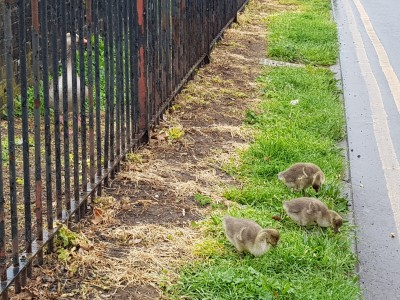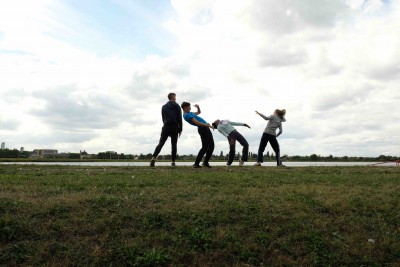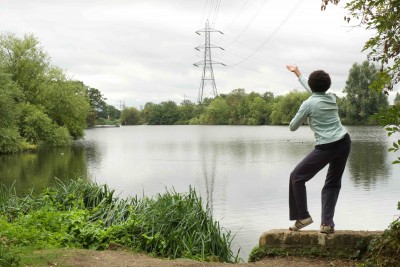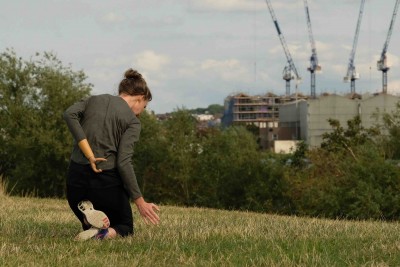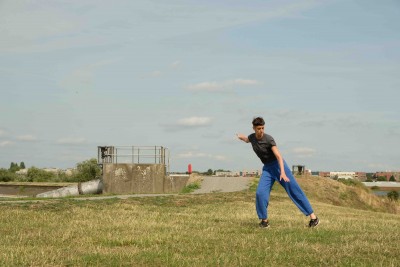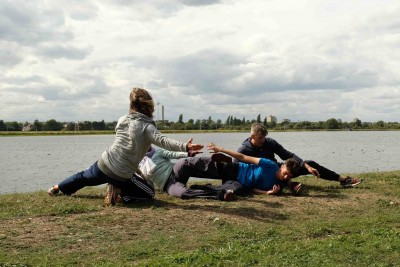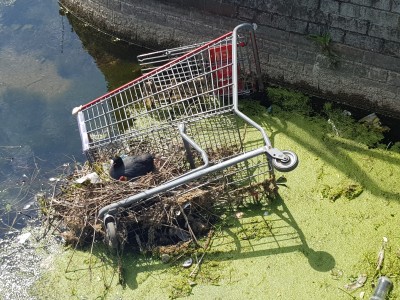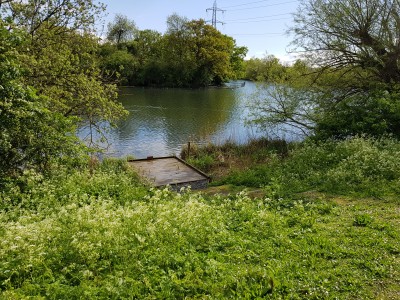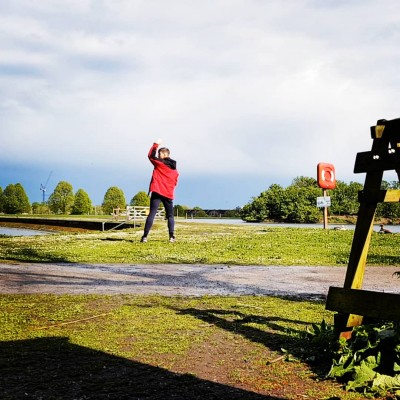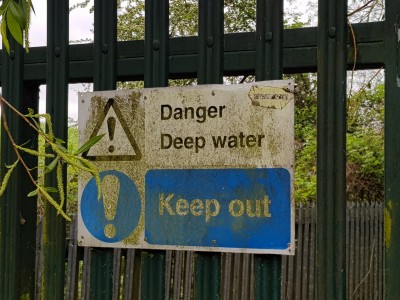Sam is a young dancer who lives in Waltham Forest. He takes classes at The Place and through his mum, he found out I was dancing on the Wetlands and sent me a video of a dance he made inspired by flying. So I invited him and his mum to join me for an afternoon on the Wetlands where we talked about the things we saw there and how I dance with some of those things in my mind. Sam noticed floating feathers and rigid, prickly seed heads that burst and disperse. He saw the water levels rising and falling on the reservoirs. He saw bees and dragonflies. We also discussed pirates. And danced.
Label: Walthamstow Wetlands Residency
Dancing with Annie, Isabella and Wanjiru: Walthamstow Wetlands Residency
I had crossed paths with Isabella Oberlander and with Wanjiru Kamuyu on my travels over the past year and, as with Annie Hanauer, knew I wanted to dance with them. Isabella I’ve known since she arrived in Limerick to take part in the Daghdha Mentoring Programme. More recently, she was a participant in a festival organised by Dance Limerick that I helped to facilitate and in which she presented her own fierce dancing. Wanjiru performed her solo choreography at Firkin Crane while I was curator there and we met again when I saw her dance in Paris during my residency at the Centre Culturel Irlandais. I mention these links because they are predicated on international mobility: this residency at the Wetlands in Walthamstow has given me an opportunity to connect ‘home’ in London to the extended, global dance that many of us are involved in. And of course, the Wetlands itself is a place that supports and sustains in birds this international migration and movement.
I appreciated the generosity and courage of Isabella, Wanjiru and Annie to dive in to the process so publicly, dancing with unfamiliar bodies in a shifting environment and climate, supporting me in bringing into being a way of human/non-human interaction on the Wetlands. Into and alongside our quartet, I invited Teresa Elwes, a photographer, passionate dancer and local resident to document some of the dancing. Her sensitive images are in this post and many more on her website.
Dancing as a quartet made us more visible, more clearly an ‘event’. I loved that some of the security guards stopped to watch our dancing, filming us and engaging in conversation about what we were doing. Our number also multiplied the energy of the dancing in a way that I couldn’t have achieved on my own. You can see some of the playful liveliness in this video sketch:
Fly in Focus: Walthamstow Wetlands Residency
Here’s a short video where the autofocus of my camera gives priority to the fly that happens to be buzzing in front of the lens rather than to the human who happens to be dancing in the background. My relatively smart camera has the technology to detect faces but here the framing doesn’t give it a face to find and so blades of grass, insects and humans passing are equally worth of digital attention.
Noticing the infrastructure: Walthamstow Wetlands
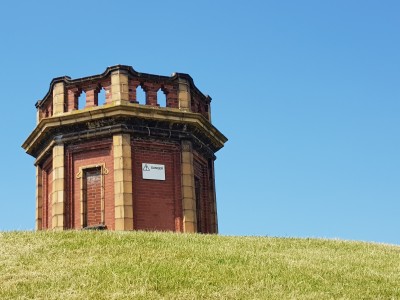 It’s easy to focus on the wildlife in the Wetlands but there is a built infrastructure of varying vintages that has made the Wetlands the place it is and continues to shape how human and non-human, organic and inorganic meets in this environment.
It’s easy to focus on the wildlife in the Wetlands but there is a built infrastructure of varying vintages that has made the Wetlands the place it is and continues to shape how human and non-human, organic and inorganic meets in this environment.
The River Lea has long been a water-way for transportation and a source of power for the various industries that were situated along its banks. The human intervention was increased when London’s need for clean water in the 19th Century brought the creation of reservoirs that transformed the landscape. For a more detailed account of the Wetlands’ history see here
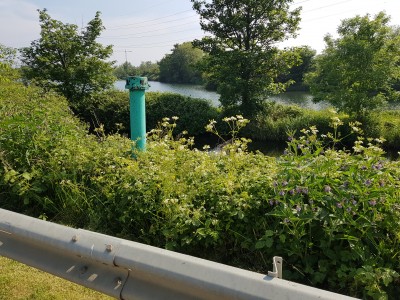 What I notice is the combination of somehow naturalized man-made elements and interventions that are more recent and contrasting. In the former category are reservoirs themselves, the picturesque pump structures (first picture above) and the weathered and patinated pieces of iron that appear here and there (and whose function I don’t yet know).
What I notice is the combination of somehow naturalized man-made elements and interventions that are more recent and contrasting. In the former category are reservoirs themselves, the picturesque pump structures (first picture above) and the weathered and patinated pieces of iron that appear here and there (and whose function I don’t yet know).
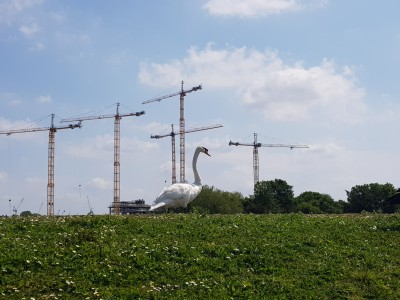 In the latter category are the temporary fencing and hazard taping that signal work in progress, the cranes on the skyline that aren’t strictly part of the Wetlands but that dominate many of its vistas. And also perhaps the unwelcome detritus, like this shopping trolley that a coot has nonetheless commandeered as a nesting site and which can’t be cleared until she’s done.
In the latter category are the temporary fencing and hazard taping that signal work in progress, the cranes on the skyline that aren’t strictly part of the Wetlands but that dominate many of its vistas. And also perhaps the unwelcome detritus, like this shopping trolley that a coot has nonetheless commandeered as a nesting site and which can’t be cleared until she’s done.
There is an admirable adaptability in this avian ability to cohabit with the human-made, but can we offer a similar willingness to adapt to the needs of the natural environment. The way some users of the site ignore requests not to cycle in sensitive areas, not to drop litter etc. suggests there’s a way to go.
Meanwhile, here’s a small dance with geese.
Quiet dances: Walthamstow Wetlands
I’ve been trying to figure out the existing choreographies on the Wetlands. The Wetlands exists because of human intervention in the landscape to provide freshwater for the capital. For an account of the history, see here. https://walthamstowwetlands.com/heritage The visible reservoirs are matched by buried tunnels and piping that channel the water through its various stages of purification and from there to Londoners across the city. There’s even a small nuclear bunker under the Copper Mill apparently that suggests a former movement script of crisis.
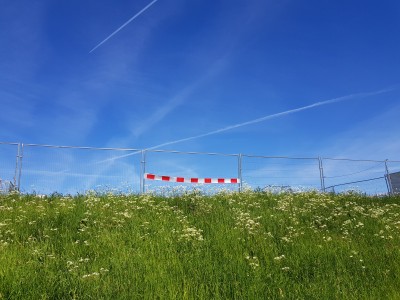
This human intervention and the fact that the general public (though not birders and anglers) have been kept out of the reservoirs has created a place where wildlife has flourished, wildlife that lives there permanently or the temporary visitors that rely on the Wetlands as one stopping point in their migration routes. The site is being managed so as to protect as much as possible the resident wildlife and that means closing particular paths at certain times of the year to enable birds to nest or to moult undisturbed. For me it also means slowing my pace when I find birds on the path and deviating if necessary. It’s also meant that I’ve be trying out quiet dancing – dances in the open space that don’t make undue noise – a dancing that I feel is co-choreographed by the requirements of the environment and its non-human inhabitants. Of course I bring my own movement history and habits to this environment, but I’m enjoying the sense that there are other choreographers in this process too.
Refuge: Finding my place on Walthamstow Wetlands
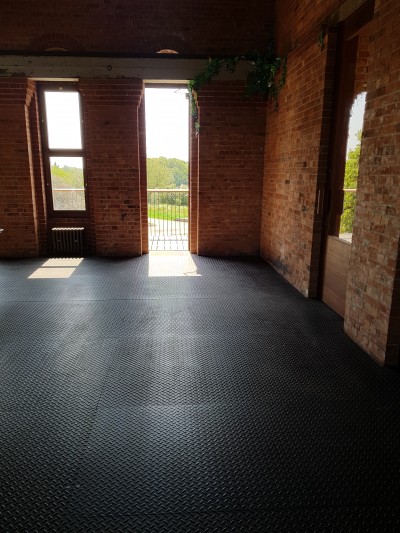 One of the themes of my residency is refuge and I’ve been wondering where my refuge is on the site. The viewing platform in the Engine House has quickly become that place for me since it has a beautiful view, there’s some space (enough for me to warm up), it is not too busy during the weekdays (but still has enough traffic to allow for some interesting conversations), it has a metal floor that is much more comfortable and forgiving than the tiled floors below and it has wifi. I’d like to have a sign that welcomes people in when I’m warming up there. I want people to feel that my work there is as natural and/or surprising as the Thames Water workers or the flora and fauna outside. And it’s also important to acknowledge that as a human I need a place to shelter, to rest, to prepare, to process. Though I’ve always been keen to bring dance beyond its comfortable familiar settings, the resilience that requires has to be supported by some care and respite.
One of the themes of my residency is refuge and I’ve been wondering where my refuge is on the site. The viewing platform in the Engine House has quickly become that place for me since it has a beautiful view, there’s some space (enough for me to warm up), it is not too busy during the weekdays (but still has enough traffic to allow for some interesting conversations), it has a metal floor that is much more comfortable and forgiving than the tiled floors below and it has wifi. I’d like to have a sign that welcomes people in when I’m warming up there. I want people to feel that my work there is as natural and/or surprising as the Thames Water workers or the flora and fauna outside. And it’s also important to acknowledge that as a human I need a place to shelter, to rest, to prepare, to process. Though I’ve always been keen to bring dance beyond its comfortable familiar settings, the resilience that requires has to be supported by some care and respite.
The success of the Wetlands opening in terms of visitor numbers means that it’s not necessarily helpful for me to attract many more people to it. However, it’s important that my work and that of the residency is visible. A mixture of visible and invisible therefore. When I mentioned this to Emma, the London Wildlife Trust Reserve Manager, she told me of the newts onsite that are undetectable to predators above because of their camouflage colouring but that have brightly coloured under-sides that they can expose to attract potential mates – safe and flamboyant. How can I be similarly discreet and attractive?
Beginning my Residency at Walthamstow Wetlands
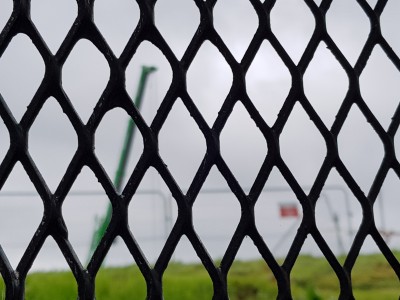 I started my stint as Artist in Residence at Walthamstow Wetlands on 2 May. The beginning wasn’t as smooth as I’d planned, though a bit of friction is always informative.
I started my stint as Artist in Residence at Walthamstow Wetlands on 2 May. The beginning wasn’t as smooth as I’d planned, though a bit of friction is always informative.
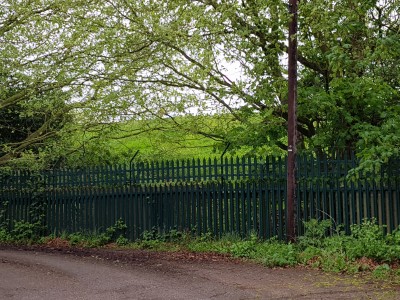
I’d been telling everyone how pleased I was that I could walk from my home in Walthamstow to work in Walthamstow – a rare convenience, and one that relies mostly on my accessing the Wetlands through the Copper Mill Lane entrance. Unfortunately the gate was closed because of Thames Water works on site and so I was confronted by the perimeter of the reserve, the long expanse of fencing that protects the sanctuary, the border that makes the Wetlands site possible as a place for refuge for wildlife.
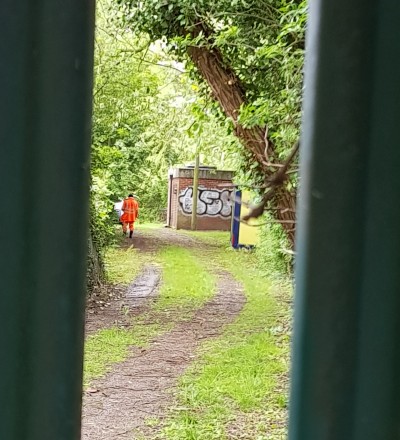
In Of Hospitality Derrida recognises that hospitality and hostility share a common etymology because he wants us to recognise that absolute hospitality has its limitations.
From a deconstructive perspective, hospitality is necessarily ‘contaminated’ by law, system, and calculation, and this contamination is emphatically not understood as an unfortunate loss of ideal purity.
Mustafa Dikeç, Nigel Clark, and Clive Barnett, ‘Extending Hospitality: Giving Space, Taking Time’, Paragraph vol. 32, no. 1 (2009), pp. 1-14, p. 9.
The notion of hospitality already implies that the host has territory, property and resources to be able to offer hospitably to others. Therefore, the borders that separate self and other, familiar and stranger are also a necessity to the ethical relationship of hospitality.
This respect for the other’s space, the other’s difference, is something that I’ve felt on the Wetlands. I’ve noticed many solitary walkers, anglers, birders and of course, the solitary (for the moment) dance artist. Though I’ve adopted what I think of as the Irish custom of greeting the people I pass on my travels around the site, it is clear that many are there for solitude and that I should respect that.
And I also noticed that for the goslings, barriers and borders are pretty porous.
